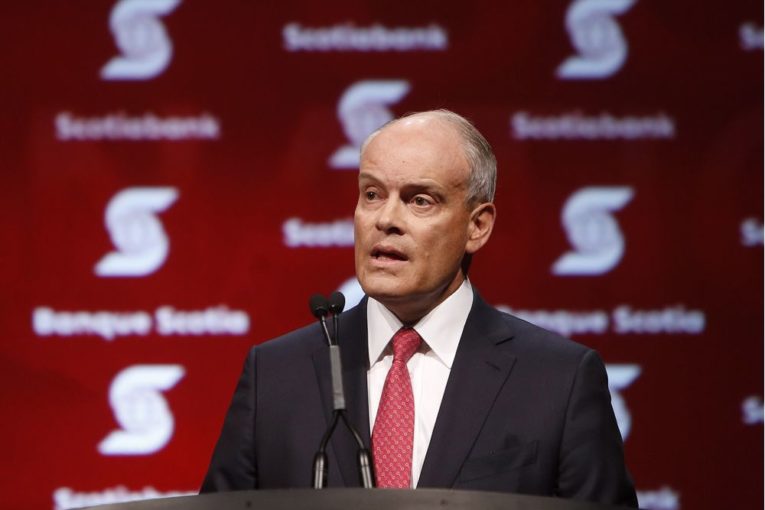
Three years ago in Ottawa, Scotiabank CEO Brian Porter told shareholders at the bank’s annual meeting that “gaps in our infrastructure will have long-term consequences for our economy and for all Canadians.”
“These projects can be game-changers for many regions across the country — and not just in the oilpatch.”
When I asked Porter why he felt it was important for him to speak out, he said: “There is an opportunity cost to the lack of progress. The numbers are dramatic and Canadians need to understand what’s at stake.”
A dramatic indicator of those costs today is the roughly $28 gap between West Texas Intermediate and Western Canada Select.
Scotiabank’s support for the energy sector was obvious.
Yet the bank, which this year became the “exclusive” sponsor of the annual investment symposium co-hosted by the Canadian Association of Petroleum Producers, has decided to bar journalists from this year’s event. Attendance for the April 10-11 sessions are on an invitation, client-only basis.
Other investment conferences held by Scotiabank’s competitors allow media to attend. In this time of declining investment sentiment in the energy sector, not to mention lacklustre share performance, going turtle makes no sense.
The annual CAPP event, which recently moved to Toronto to reach investors there, has always been open to the reporters. It’s an important, annual opportunity to catch up with industry players and get a comprehensive picture of the challenges and the outlook for the industry and present it to Canadians.
The reality is that many Canadians — through their direct or indirect investments — hold shares in Canada’s oilpatch players.
Last year, following significant transactions involving Canadian Natural Resources, Cenovus and Suncor, the investment symposium presented an opportunity to hear, first-hand, about the plans for integration, associated asset sales and how the companies intended to leverage the value of their augmented assets.
In the 12 months since last year’s conference, the energy sector has been a rough and tumble place.
Talk to anyone — company, investment banker, private equity player — and they will point out that it’s difficult to gain traction with investors. Energy simply isn’t on the radar.
And that’s despite stronger oil prices, stronger bottom-line results, lower operating costs, a number of companies re-introducing or increasing dividends and instituting share buybacks.
Some of the diminished interest is undoubtedly due to the lack of progress on pipeline construction. Since Porter’s remarks, the Trans Mountain expansion was approved but continues to face opposition, and with higher taxes and regulatory uncertainty, it might be investors are also tuning out because of the constant negative narrative from Canada’s oilpatch.
The energy sector, by its own admission, is a lousy communicator.
It has done a less than admirable job telling its story — of how hydrocarbons are produced, how that process has changed and, perhaps most importantly, making the link between its production and the lives of everyone on the planet.
As Enbridge says, life takes energy. As does economic growth.
Events such as CAPP’s investment symposium have offered the oilpatch the chance to better tell that story, to investors, other stakeholders, and yes, the media.
The opportunity to stand alongside a CEO in a buffet line or while grabbing a coffee establishes new connections, which can further enhance the understanding of a particular company.
But that’s off the table this year.
Did CAPP consider that by excluding media it is doing more harm when there are questions within the oilpatch as to its relevance — and effectiveness?
Asked about the decision to exclude media, CAPP spokeswoman Chelsea Klassen said: “This is the first year Scotiabank is producing the entire conference and it is Scotiabank’s standard practice for institutional investment conferences to be closed to the media. We recognize the broader issues on industry competitiveness and the need for a broader conversation with media.”
CAPP will help bridge the gap by releasing the second of a seven-part examination of the energy sector’s economic impacts ahead of the conference.
But the harm will have been done — particularly at a time when there are questions within the oilpatch as to the organization’s relevance and effectiveness?
It was a different world when CAPP came created in 1992. The Canadian oilpatch was fairly simple: conventional oil and natural gas production. The oilsands had yet to have their commercial breakthrough and horizontal drilling was in its nascent stage.
It’s a different, multi-channel energy sector today — whether in the oilsands, which now produces from mining and in-situ sites, tight gas and light tight oil, alongside the conventional pools that continue to be produced using new or improved technology.
And there has been a growing question whether one industry advocate such as CAPP is what’s required for a sector that no longer can be uniformly described. Factor in the fragmentation of the media itself and both the question and solution become even more complex.
The kiss of death for any company, industry or even government is an inconsistent or distorted message. Too many actors and things get confusing, which is a risk for CAPP if it can’t find a way to unify its members.
Ultimately, CAPP’s mandate is to serve the industry and its members. By barring media from its annual conference, it is arguably not fulfilling its mandate.
And Scotiabank, having vocally supported the importance of the energy sector to the country almost three years ago, now looks hypocritical.
Deborah Yedlin is a Calgary Herald columnist
You can read more of the news on source
